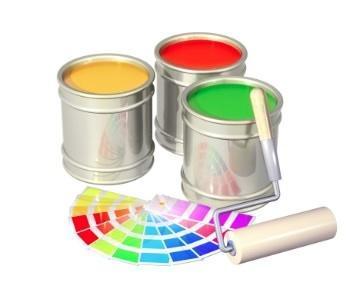Painting the house
Post from EditorialsPainting the walls is an opportunity to renew the premises of your house: Let's see now how to proceed after choosing and purchasing the right color.
Preparation to paint the walls of the house
 After purchasing the right color for the walls of your house, the operation to be performed before starting the painting is to make sure that all surfaces are clean, compact, dry and free from dust.
After purchasing the right color for the walls of your house, the operation to be performed before starting the painting is to make sure that all surfaces are clean, compact, dry and free from dust.
To this end, wipe it with a dark damp: if you highlight residues, it will be necessary to apply a compacting base. You then need to remove the old layers of paint with water and brush. It is also essential to fill the cracks and fill the eventual holes or gradients, etc..
 One of the most annoying part is to cover with adhesive tape (masking tape) the edges of the baseboards, the window and door frames, electrical outlets, chandeliers, and anything else that does not need to be painted.
One of the most annoying part is to cover with adhesive tape (masking tape) the edges of the baseboards, the window and door frames, electrical outlets, chandeliers, and anything else that does not need to be painted.
Carrying out this step with good accuracy will ensure an excellent final result and the fact of not having to meticulously clean every drop of color that has fallen out afterwards. In the market there are different types of tape for every need: they usually have a band of nylon cloth of varying lengths in order to simplify the job.
It 's always important to set very carefully the nylon cloth on the floor to avoid, once applied the painting on the ceiling, any falls caused by slipping.
On the very absorbent walls (of gypsum plaster for example), it is advisable to apply a base in order to avoid excessive absorption of paint.
Equipment to paint the walls of the house
Spatula for filling any cracks or leaks
Bucket or plastic container for dipping the roller
A roller or a flat brush, a brush, a round brush
A steel staircase
Gloves
Protective Eyewear
Overalls for paint  Once you purchase the color, you will need to dilute it according to the manufacturer's instructions, and mix it thoroughly to remove any lumps: Usually this can be done with a drill in which to apply the appropriate tip, otherwise you can use an old immersion cooking blender.
Once you purchase the color, you will need to dilute it according to the manufacturer's instructions, and mix it thoroughly to remove any lumps: Usually this can be done with a drill in which to apply the appropriate tip, otherwise you can use an old immersion cooking blender.
At this point, to evenly apply the color and eliminate the excess, pass the roller on the grid which will be fixed on the upper edge of the bucket of the painting.
To lay the bottom lay use a wide, flat brush or a brush.
How to proceed to whitewash the walls of the house
 The correct procedure for the painting of the room by painting part of the ceiling, which will be realized with a roller which will be applied to a telescopic handle so as to avoid ascents and descents on the stairs.
The correct procedure for the painting of the room by painting part of the ceiling, which will be realized with a roller which will be applied to a telescopic handle so as to avoid ascents and descents on the stairs.
Then it continues with the painting of the angles, beginning with those of the windows, to be achieved with a broad brush.
For a correct compilation of painting, started first by passing the roller vertically and then horizontally, in order to distribute the color evenly and uniformly.
Go quietly painting on the elements covered by masking tape, so as to coat well anywhere in the room. If you have not applied the tape may well be that the paint run down the cracks, therefore, be doubly careful when drafting the tape.
To simplify and optimize the work, try to move elements as possible (sofa, furniture, tables, chairs, furniture, etc..) in the center of the room in order to free up the walls, to dye them more easily. Depending on the need, roll out one or two coats of color. Beware, though: over the years roll causes an excessive layers of paint flaking off of the wall that make it difficult for subsequent applications.
Depending on the need, roll out one or two coats of color. Beware, though: over the years roll causes an excessive layers of paint flaking off of the wall that make it difficult for subsequent applications.
So if you painted the walls every one to two years, lay only a single coat of color, otherwise if painted less frequently, every three to four years would be ideal, apply two coats of color.
Generally, between a layer and the other is good to wait a day for the drying of the color; indications are provided properly and accurately from every manufacturer on the packaging of the purchased painting.

Cleaning the residual color
Next you will need to clean any residual color from the elements accidentally painted: simply use a sponge with a bit of warm water and a simple detergent.
The critical points are almost always the baseboards, the sockets, the doors and windows edges and the chandeliers: be patient and proceed to cleaning.
Cleaning of painting tools
At the end of the work you will need to clean all the tools used: it is good to let them soak in warm water for a few hours so as to facilitate the cleaning later. Most of the time it is sufficient to wash the brushes and roller with a simple dish washing detergent or degreaser, otherwise you will need to use a diluent.
79741 REGISTERED USERS










